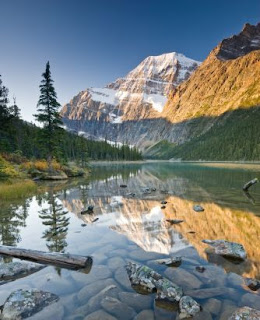Search This Blog
Back on the Coast
Friday, February 29, 2008
12 Practical Steps for Learning to Go With the Flow
Reprinted with Granted Permission via Uncopyright
"Life is a series of natural and spontaneous changes. Don't resist them - that only creates sorrow. Let reality be reality. Let things flow naturally forward in whatever way they like." - Lao-Tzu
No matter how much structure we create in our lives, no matter how many good habits we build, there will always be things that we cannot control - and if we let them, these things can be a huge source of anger, frustration and stress.
The simple solution: learn to go with the flow.
For example, let's say you've created the perfect peaceful morning routine. You've structured your mornings so that you do things that bring you calm and happiness. And then a water pipe bursts in your bathroom and you spend a stressful morning trying to clean up the mess and get the pipe fixed.
You get angry. You are disappointed, because you didn't get to do your morning routine. Your are stressed from all these changes to what you're used to. It ruins your day because you're frustrated for the rest of the day.
Not the best way to handle things, is it? And yet if we are honest, most of us have problems like this, with things that disrupt how we like things, with people who change what we are used to, with life when it doesn't go the way we want it to go.
Go with the flow.
What is going with the flow? It's rolling with the punches. It's accepting change without getting angry or frustrated. It's taking what life gives you, rather than trying to mold life to be exactly as you want it to be.
"Flow with whatever is happening and let your mind be free. Stay centered by accepting whatever you are doing. This is the ultimate." - Chuang Tzu
A reader recently asked me to write more about going with the flow, so this is my attempt to share some of the things that work for me. As always, I don't have and claims to perfection, and I'm learning as I improve, but the tips below should help anyone.
1/ Realize that you can't control everything. I think we all know this at some level, but the way we think and act and feel many times contradicts this basic truth. We don't control the universe, and yet we seem to wish we could. All the wishful thinking won't make it so. You can't even control everything within your own little sphere of influence - you can influence things, but many things are simply out of your control. In the example above, you can control your morning routine, but there will be things that happen from time to time (someone's sick, accidents happen, phone call comes at 5 a.m. that disrupts things, etc.), that will make you break your routine. First step is to realize that these things will happen. Not might happen, but will. There are things that we cannot control what will affect every aspect of our lives, and we must, must, must accept that, or we will be constantly be frustrated. Meditate on this for awhile.
2/ Become aware. I've mentioned this step in previous articles on other topics, but that's because it's extremely important. You can't change things in your head if you're not aware of them. You have to become an observer of your thoughts, a self-examiner. Be aware that you're getting upset, so that you can do something about it. It helps to keep tally marks in a little notebook for a week - every time you get upset, put a little tally. That's all - just keep tally. And soon, because of that little act, you will become more aware of your anger and frustration.
3/ Breathe. When you fell yourself getting angry or frustrated, take a deep breath. Take a few. This is an important step that allows you to calm down and do the rest of the things on this list. Practice this by itself and you'll have come a long way already.
4/ Get perspective. This always helps me. I get angry over something happening - my car breaks down, my kids ruin my microwave - and then I take a deep breath, and take a step back. You know how you're watching a movie and the camera zooms away and you can see much more of the world on the screen that you could before? How it goes from closeup to a larger, panoramic view of things? That's what happens in my mind's eye. I start to zoom away, until I'm pretty far away from things. Then whatever happened doesn't seem so important. A week from now, a year from now, this little incident won't matter a single whit. No one will care, not even you. So why get upset about it? Just let it go, and zoom it won't be a big deal.
5/ Practice. It's important to realize that, just like when you learn any skill, you probably won't be good at this at first. Who is good when they are first learning to write, or read, or drive? No one I know. Skills come with practice. So when you first learn to go with the flow, you will mess up. You will stumble and fall. That's OK - it's part of the process. Just keep practicing, and you'll get the hang of it.
6/Baby steps. Along the same lines, take things in small steps. Don't try to bite off huge chunks - just bite off something small at first. So make your first attempts to go with the flow small ones: focus on the tally marks (mentioned above) first. Then focus on breathing. Then try to get perspective after you breathe. And you might try the easier situations first - if your work problems are easier to accept that your frustrations with your kids, for example, start with work.
7/ Laugh. It helps me to see things as funny, rather than frustrating. Car broke down in the middle of traffic and I have no cell phone or spare tire? Laugh at my own incompetence. Laugh at the absurdity of the situation. That requires a certain amount of detachment - you can laugh at the situation if you're above it, but not within it. And that detachment is a good thing. If you can learn to laugh at things, you've come a long way.
8/ Keep a journal. This is one of the best uses of a journal actually. Once a day, try to recall what all your tally marks were for - and then write about those situations. Why did you get upset? What did you try to do? Did it work, and if not, why not? What can you do next time? This kind of recollection and examination, after the fact, will help you learn from the process.
9/ Meditate. If your aren't good at keeping a journal, at least do a daily review in your head. Do some meditation, or have a bath, or a cup of hot tea, and as you're de-stressing, go over your day and examine it. Don't get frustrated - you're learning. Do some deep breathing, and them go over each situation, trying to see it as a detached observer. This kind of review will help you improve in the learning process.
10/ Realize that you can't control others. Ah, one of the biggest challenges. We get frustrated with other people, because they don't act the way we want them to act. Maybe it's our kids, maybe it's our spouse or significant other, maybe it's our coworker or boss, maybe it's our mom or best friend. But we have to realize that they are acting according to their personality, according to what they feel is right, and they are not going to do what we want all of the time. And we have to accept that. Accept that we can't control them, accept them for who they are, accept the things they do.
11/ Accept change and imperfection. When we get things the way we like them, we usually don't want them to change. But they will change. It's a fact of life. We cannot keep things the way we want them to be ... instead, it's better to learn to accept things as they are. Accept that the world is constantly changing, and we are a part of that change. Also, instead of wanting things to be "perfect" (and what is perfect anyway?), we should accept that they will never be perfect, and we must accept good instead.
12/ Enjoy life as a flow of change, chaos and beauty. Remember when I asked what "perfect" is, in the paragraph above? It's actually a very interesting question. Does perfect mean the ideal life and world that we have in our heads? Do we have an ideal that we try to make the world conform to? Because that will likely never happen. Instead, try seeing the world as perfect the way it is. It's messy, chaotic, painful, sad, dirty ... and completely perfect. The world is beautiful, just as it is. Life is not something static, but a flow of change, never staying the some, always getting messier and more chaotic, always beautiful. There is beauty in everything around us, if we look at it as perfect.
"I accept chaos. I am not sure whether it accepts me." - Bob Dylan
Wednesday, February 27, 2008
The Budget
IMPORTANT CONSIDERATION!!!! This budget is based on my lifestyle, and my jurisdiction. I may allocate funds not as you would spend them, so your budgets' expenses will definitely vary. Also, depending on where you live in, the basic costs for food, fuel and health insurance have huge variance!! For example, if I lived in Southern Ontario, Canada, I could reduce this budget by $200/month, quite easily. If I lived in the States, I could probably reduce the budget again by another $200/month!
In my budget, I allocate funds for specific expenses, fuel and food, higher than would you would normally expect on purpose. That way, for the average month of the year, some of the money rolls over into an emergency savings fund. This fund is for extraordinary expenses, ie. expensive auto repairs and occasional expensive purchases.
My Basic Monthly Budget (based on monthly costs in British Columbia (BC), Canada)
Food: $300
Fuel: $250
Cellphone: $50
Auto insurance: $90
Medical insurance: $55
Health Club: $65
Auto repair, Tags: $60
Clothing: $50
Haircut: $20
General Misc.: $60
Entertainment: $200
Monthly Total: $1,200
Major Expense Considerations:
1/ Food - Hey, I like to eat well, and food has become very expensive here in BC. Even the provincial government claims it costs $250/month, for an average healthy male adult to have a good diet. I usually save some money on this expense because quite often I get a free meal from friends and family. Sometimes, people I know will give me free produce from their garden or farm. Hunters and fishermen I know give me free salmon or venison. These folks are all part of my network, and I reciprocate by helping them as well. So, on the average month, I roll over around $100 into my emergency fund (important). It also varies greatly depending on region, what costs me $4 for food items here in BC, only costs $3 in Ontario.
2/ Fuel - We get taxed heavily in Canada on motor fuel, and the oil industry creates huge price variances by jurisdiction. As of today and where I live, the gasoline price right now is hovering around $1.20/litre, which translates to $5.45/Can. gallon or $4.54/US gallon. Our monies, Canada vs. USA, are approximately par lately. So, that's right US folks, $4.50 +++ a gallon; it's been over $4/gallon for years. In Toronto, Ontario, the same fuel costs around $1.03/litre, a 15.5% decrease comparitively. In the States, fuel costs vary but the average seems to presently $3.13/US gallon, which breaks down to $0.83/litre (45% less than I pay!!!). So, you can see why I start with such a high figure!
Your gas usage will also vary with the mileage you drive and many other factors. The money that I allocate to fuel covers my average weekly driving, around town and short trips on the weekend. Sometimes, I save a little money here, maybe up to $50/month, which gets rolled over into the emergency fund. Depends.
Cellphone - Cellular plans in Canada are more costly than in the States, and I talk a fair bit. It just what it costs.
Insurances - Basic Auto insurance, with some extra coverage, costs this much here in BC. You have to use the provincial-run monopoly for basic coverage, and this is what they charge.
But, medical insurance has great variance, depending on where you live. Basic coverage in my province is $55/month; in other provinces, such as Ontario, it is free. In the States, medical insurance seems to be very expensive, and many vandwellers do without.
Auto repair, Tags: In BC, our annual license plates costs around $65. Also, there is always some small expenditure for maintenance needed on your vehicle; light repairs, oil changes, coolant, windshield wiper juice, light bulbs, assorted little relays and fuses, whatever. So, I allocate funds on a monthly basis towards this.
Entertainment: I like to go out a little and do things. I like to see the occasional movie. I like to go to the pub once in a while, and enjoy a couple of pints. I like to have a frugal meal out at the local diner with a friend or date. Quite often, I can blow this expense easily, but that money comes from other savings. On a regular basis, this is the sum I usually spend.
My Emergency Fund - From my budget design, I usually roll over $150 per average month into this fund. It is placed into a specific savings account, which is not accessible by debit card (important). I try to use this money only for important purchases; major auto repair or costly clothing (good footwear or pricey coats, etc). In two years of full time vandwelling, I have accumulated just over $3,000. So, if I have to rebuild an engine or transmission, or have an expensive repair bill (brake work, front end, new tires, etc.), I can cover all or most of it from this fund. Right now, since these types of repairs are not necessary, I'm going to dip into it for other purchases. But, I will leave $2000 there as a minimum on which to build up again.
To sum up, your particular monthly budget will vary greatly by lifestyle and where you live. I have always joked that BC doesn't stand for British Columbia, but for Bring Cash (lots of it!). It is very expensive to live here. But, luckily for me, I have the ability to make decent money, so this monthly budget is relatively easy to afford, and I usually have extra savings above what I have discussed here. I feel it is good to know where you spend your money, budget to live within your means, and feel comfortable with your lifestyle. Good fortune to you and yours.
Sunday, February 24, 2008
Code of the Road
1/ Treat people how you want to be treated. I use this basic belief, whether I am driving, walking down the road, buying stuff in a store, at work with customers and fellow staff, my friends, my family or strangers. It doesn't make any difference to me who they are or whatever attitude someone approaches me with. Most people are pretty decent, and will lighten up when you treat them with honesty, kindness and respect.
I realize that you may not want to be this fair to a lot of people; like some rude, dumbass jerk or maybe police and other authoritative people. But, they might just be having a bad day, and upon meeting a decent 'you', they might come around. If they don't, just deal with them at arm's length and walk away. It's your call, every situation is different. Tip: Don't argue or be rude with a cop, you're only asking for more trouble than it's worth.
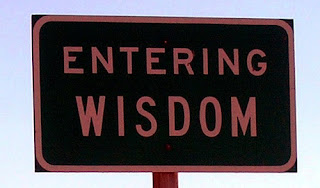 2/ Drive to arrive alive. Slow down, you'll save gas. Pay attention. Don't drive tired or under the influence of whatever. Take breaks. Eat. There is no fire, you'll get there in good time. Don't drive like an idiot, there's enough of them out there already.
2/ Drive to arrive alive. Slow down, you'll save gas. Pay attention. Don't drive tired or under the influence of whatever. Take breaks. Eat. There is no fire, you'll get there in good time. Don't drive like an idiot, there's enough of them out there already. A special note about motoring around truckers. Please be careful around big semis or trucks. Truck drivers have a hard enough job already; long hours, heavy and difficult rigs to stop or manoeuvre, arduous schedules to meet. So be understanding of what they are dealing with and act accordingly. Give them lots of room, allow them to pass easily, stay way back when following from behind. It's mostly for your safety, I mention this.
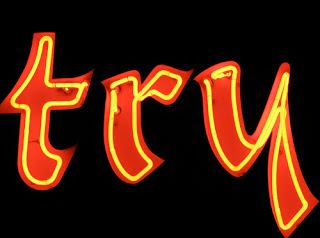 3/ Be prepared. Got this one right from Boy Scouts, and it still rings true. Why? Finangle's corollary to Murphy's Law states; "Anything that can go wrong, will - at the worst possible moment." Like out in the middle of nowhere during a blizzard. Make sure your vehicle is safe and well maintained, to avoid roadside breakdowns. Make sure you are prepared with survival gear, if need be. Be ready.
3/ Be prepared. Got this one right from Boy Scouts, and it still rings true. Why? Finangle's corollary to Murphy's Law states; "Anything that can go wrong, will - at the worst possible moment." Like out in the middle of nowhere during a blizzard. Make sure your vehicle is safe and well maintained, to avoid roadside breakdowns. Make sure you are prepared with survival gear, if need be. Be ready.
I apologize if I sound like I am lecturing. But I must admit, I am. Somewhere along the line, a lot of people lost their sense of common decency, and took up a "Just look out for me" type attitude. It's a shame. It doesn't work. We are all in this world, together. We all effect each other. So if you feel up to it, try committing the occasional, random act of kindness. If enough of us did, the world could be a different place, wouldn't it.
Friday, February 22, 2008
Money and Common Sense, Again
 In my area, the average low end apartment rents $750/month; let's say you furnish it frugally for $1,500; utilities will run around $30/month and household insurance will be around the same @ $30/ month - that will represent a total cost of $30,660. Now some of you will say you could live in a cheaper place; sure, if you can find one. Show me. I have found in the last couple years, rental vacancy has gone way down; they aren't building rentals now, only condominiums. You might find a room in a house, but then you don't have any sense of autonomy; there is always people in your space.
In my area, the average low end apartment rents $750/month; let's say you furnish it frugally for $1,500; utilities will run around $30/month and household insurance will be around the same @ $30/ month - that will represent a total cost of $30,660. Now some of you will say you could live in a cheaper place; sure, if you can find one. Show me. I have found in the last couple years, rental vacancy has gone way down; they aren't building rentals now, only condominiums. You might find a room in a house, but then you don't have any sense of autonomy; there is always people in your space. All other costs are the same, more or less. Food, health insurance, telephone (cell), entertainment; they don't change. If you go on a trip, well, you would have incurred extra expenses which you would budgeted for regardless. As far as computers go, you exchange your desktop for a laptop, a land line feed for a wifi card, more or less the same.
All other costs are the same, more or less. Food, health insurance, telephone (cell), entertainment; they don't change. If you go on a trip, well, you would have incurred extra expenses which you would budgeted for regardless. As far as computers go, you exchange your desktop for a laptop, a land line feed for a wifi card, more or less the same.
Above: Exciting new cities to explore, like Vancouver, BC
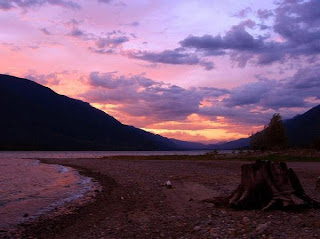
Wednesday, February 20, 2008
More Night Parking - Some Stealth, some Not.
More Stealth Night Parking:
1/ Industrial Areas - Some vandwellers like industrial areas for night parking and with good reason. If you have a box or white cargo van, you look like you belong there (important). There are usually few people around (business done daytime), and lots of no restriction parking. But, the people that are around, alarm me. You gotta' really choose your spot wisely; some industrial areas are known for prostitution and drug trafficking. Some companies or industrial malls have inquisitive security services, which will scope out your van wondering why it is the only vehicle there. Same for the police. I like to remain under the 'radar' of these groups, so I only park where I know my presence won't attract them. For myself, I don't care much for industrial areas; don't like the vibe!
2/ Shopping Malls - Depends on the size and parking restrictions. A huge parking lot with one lonely van par
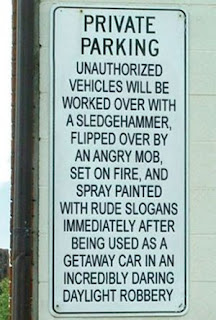 ked for the night, is just asking for trouble. Instead, I like small strip malls, with usually no parking restrictions, where you sorta blend in. It's attracting the wrong elements you want to avoid; thieves, rowdies, security and police. So I go to some casual little suburban lot, where things are low key and maybe there are some other vehicles parked.
ked for the night, is just asking for trouble. Instead, I like small strip malls, with usually no parking restrictions, where you sorta blend in. It's attracting the wrong elements you want to avoid; thieves, rowdies, security and police. So I go to some casual little suburban lot, where things are low key and maybe there are some other vehicles parked.Left: You gotta' pay attention to signage!
3/ 24 Hours Stores (And Walmart) - In my area, there aren't any large 24hr. stores, with large parking lots, where you could utilize stealth sleeping mode. The convenience stores which stay open 24 hrs., usually attract a lot of people I wish to avoid. Some places there are 24 hour food supermarkets, where you could definitely use their lots.
I mention Walmart here. That's because, although you are allowed to use their lots for overnight parking, I only do so as a last resort. I don't like being on display for the local cops as a van owner, who is also an urban camper; they check out these lots and pay attention to who is there. Then if they spot you on the street later on, they might hassle you. If I use a Walmart lot, I use one that is far out of my usual area, or when I am travelling on the open road.
4/ Around Nightclubs and Bars - To some degree, this makes sense. Patrons who get too drunk to drive, may wisely choose to leave their vehicles behind. So you can usually park overnight. But, the area will be noisy with drunk patrons, and may be watched by security, police and staff. You gotta' scope it out to see if it feels right.
5/ Hotel/Motel parking lots - The idea is that you just drive in and park like you belong there. But, do you homework first. Some hotels have security with night watchman and live video cameras. Some hotels have parking passes which must be displayed on the dashboard. I don't use this method, unless I've stayed at the place, and thoroughly know how they operate.
6/ Hospital lots - I kinda group this method into the above. In the cities where I live, they are all pay parking lots (not a frugal choice), and there is security around. However in smaller towns, the opposite is quite often the case; no fees, and no security.
7/ Apartment/Condo complexes - These can be good and bad. You must know where the guest parking is, so you don't attract negative attention. You gotta' know the rules of how they operate; do they allow overnight parking?; do you need to have a note on the dashboard indicating who you are supposed to be visiting? There are quite often a lot of inquisitive residents to hide from as well. But, once you get past those challenges, you should be OK. Just don't park there very often.
Non-Stealth Modes:
Some night parking doesn't require you to be stealthy at all. That is because you are allowed to be there legally; sometimes a fee is required, sometimes not. Here are a few ideas:
1/ Campgrounds - I'm sure you know what's involved here. But, there are some aspects you might consider. In the off tourist season, campgrounds quite often drop their overnight rates by 2/3; as an occasional stay, they are economical and a welcome respite from the street. Private campgrounds may rent you a spot monthly, which could have reasonable rent and possibly hydro, showers and laundry available. Depending on costs, it's an option to consider.
2/ Friends or family homes - These folks are my network, and we all rely on each other for support. They usually have a bedroom ready for me, so I can do work on my van, which I can't do on the street. But, they are a safety outlet as well. If I am being hassled by the police for urban camping, this network has given me permission to call their homes, my home. Then when police inquire about my present residence, I state that I am couch surfing at one of the 'network' places. I can drive and park there anytime, if necessary.
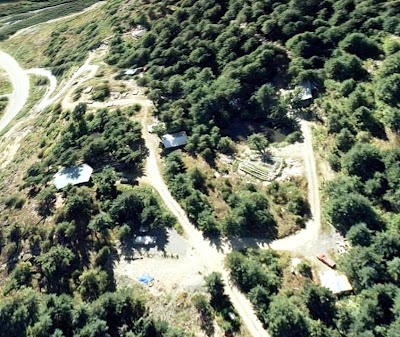
Above: This aeriel view is a private property I once camped on. I worked a little in lieu of rent, and I was located only seven miles from my resort employment. The area to the lower right was my corner; it was shranga-la-di-da! I loved staying here.
3/Private Property - If you can get permission from an owner, this can be a great opportunity. I had a casual corner on a Whistler property for 3 months once. I did a little work in lieu of rent, and there were no neighbors that could see or care about my presence. I loved it. This can be an ideal camp spot.
4/ Employment - Sometimes you can find a gig, where someone wants a 'presence' to be on a specific site or property. That 'presence' could be you, in the form of some casual security. Just what kind of security services you want to provide is up to you; it could be dangerous dealing with desperate thieves.
As you can see, the options available to the vandweller are many and varied. In stealth mode, I like to mix up where I sleep continuously, so it's hard for anyone to become aware I'm around. By the time they do, I'm gone and they forget about me. That's because I never sleep in the same place two nights in a row, and I usually don't return for at least a month.
Parking in places where you have permission is obviously more comfortable. You don't have to hide and you can settle down. That is what I am doing right now. When I go to the next city, I will be checking out all private property options available. As a modern nomad, I take advantage of good opportunities, as I find them.
Saturday, February 16, 2008
Keeping Warm, Part Two
Insulation - If you are going to try to heat your van, it is necessary to insulate sufficiently. Otherwise, the heat will just escape and have little effect. The exterior surfaces to focus on would be the roof and sides of the 'room', 'cuz these walls hold in and down heat which rises upwards. Curtains could be applied to the doors and behind the drivers' seat, to further contain heat and stop drafts. The floor should receive some consideration, but is not as important. Different methods of insulation will be discussed in a later series of articles; I'm working on renovating my own van, as this is being written.
Safety - This consideration is critical. If you are introducing systems that your vehicle wasn't designed for, you must take extra precautions. Have a fire extinguisher mounted conveniently. Use smoke detectors, use CO detectors, use propane detectors - whatever is applicable. Even consider having a fire escape plan to quickly leave your bed and get out of your van; it could save your life.
Some options available:
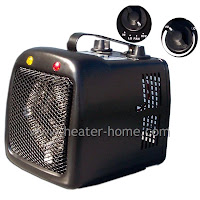 ter that your expenses are minimal; if some precautions are taken, the fire risk is quite low. There are quite a few vandwellers that take advantage of this method, and I am prepared to do so whenever I can. All you need is one of those little black cube heaters and a heavy-duty exterior extension cord.
ter that your expenses are minimal; if some precautions are taken, the fire risk is quite low. There are quite a few vandwellers that take advantage of this method, and I am prepared to do so whenever I can. All you need is one of those little black cube heaters and a heavy-duty exterior extension cord. Left: This small heater is built extra tough with a metal exterior case, and the fan motor and controls well vented for long service. It retails for around $50 and puts out up 5K BTU/hr. Unfortunately, ya' gotta' plug it in to an 120 volt shore power source.
3/ Small Portable Propane Heaters - These come in both open flame and catalytic design, you know the little heaters for camping or small spaces. I don't care for these because of several reasons. One, the fire risk. They aren't really built for durability, they are easy to bump into and knock around; they have high temperature external surfaces. That could spell disaster in a small contained space, with yourself and pets moving about. Two, exhaust gases. These units are vent free, which means they use the oxygen from the interior space, and vent the exhaust gases into the same air volume. The one you breath and live in. There are too many documented examples of death, resulting from these units being incorrectly used in enclosed spaces, when the all-important ventilation necessary was compromised. The low cost doesn't justify the risk in my mind; I'd rather do with no heat instead.
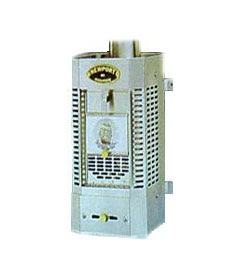 4/ Compact Airtight Fireplace - Some people use small wood fireplaces, but I think they would be unpractical and unsafe. In the confined space of a 'mini' or full-size van, I can't really them working out. In a larger step or box van, with open spaces and clearances, for sure. They do use small wood stoves in school bus conversions, where there is lots of space. However, the smoke plume from the flue would not help your urban stealth mode, probably attracting the police or fire department. But used out in the country, way cool.
4/ Compact Airtight Fireplace - Some people use small wood fireplaces, but I think they would be unpractical and unsafe. In the confined space of a 'mini' or full-size van, I can't really them working out. In a larger step or box van, with open spaces and clearances, for sure. They do use small wood stoves in school bus conversions, where there is lots of space. However, the smoke plume from the flue would not help your urban stealth mode, probably attracting the police or fire department. But used out in the country, way cool.Left: Newport Marine solid-fuel microfurnace. Mounted on a fire-resistant panel, with a 3" flue, it's size is 16" high, 8" wide and 10" deep. Uses wood, charcoal briquette or coal. Retails for approx. $500, but there could be a cheaper version out there.
5/ Propane Camper or RV Furnace - If it wasn't for the prohibitive expense, this would be the way to go. You wouldn't be tied to shore power, and you would have safe heat anywhere. But, the cost. The cheapest brand new system I've figured out, would run somewhere around a $1,000 to implement, and would only work for a full-size van. The only system I could figure out for my mini-van, would run about $2,000 to install. But, you could take the system from your present van to the next owned van, reducing the extended cost.

Left: Atwood Everstar 8012-II propane furnace. The standard type RV unit, it produces 12K BTU/hr and it's size is 21" long, 12" high and 9" wide. Although it has a bulky size, it can be placed in cabinets with tight clearances, costs around $400 for the unit and draws only 1.8 amp current.
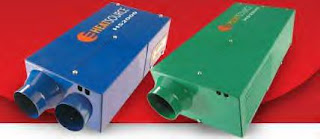
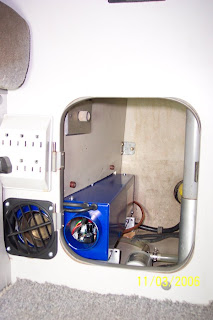
Two photos, to the right and above: Propex Micro Furnaces. If I was going to install a heater in my minivan, this would be my choice. Very high tech., very compact but very expensive ($800+ for just the unit). They put out around 3-4K BTU/hr, are very safe and efficient.
A system like this requires an internal furnace, exterior propane storage, gas plumbing, control and safety systems, and a house battery system for 12 volt system requirements. This is usually why you see them in vehicles which are commercially converted for van camping. It's a lot of processes to deal with, and unless you are very capable, probably best left for the professionals to install. You could be able to pick up a used system, but you would have to diagnose it's safety and operational value. Could be dicey.
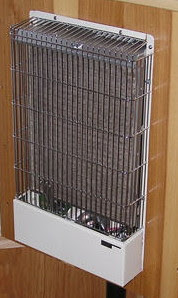

Left: Platinum Cat Heater. Although the Olympian Wave brand is more popular, I would prefer this unit. It is vented, so the unit doesn't dump moisture and exhaust gases into the interior air.
Right: Force 10 Marine Cabin Heater. If I had a full-size van, this is the unit I would go with. It produces 6K BTU/hr and is 16" high and both 8" wide and deep. Retailing for around $450, it doesn't require a house battery system for electrical system power; a big savings. It is also vented, removing harmful exhaust gases and moisture via a 1" flue.
For my mini-van and my lifestyle, options 1 or 2 would suit me. If I had a full-size van, I would definitely consider option 5. What's going to work for you, you must decide. But whatever you do, please, please, please - consider safety first over saving money; option 3 is very risky! It's better to pile on a bunch of comforters, instead of risking your life. Think about it. Happy Trails!
Thursday, February 14, 2008
Keeping Warm, Part One
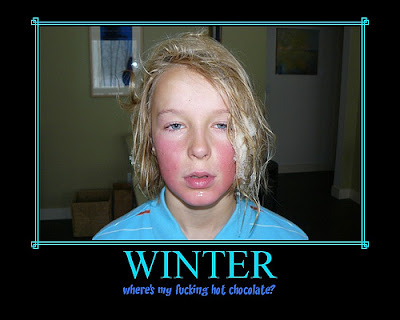
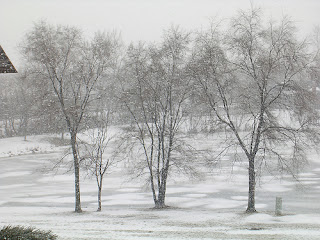
Left: It's cold outside!
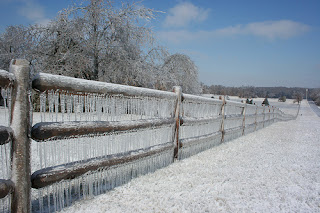
Left: At least, it gets cheery and bright!
 ates around 250 BTU's per hour; it's what keeps you warm when just wearing a coat outside. But, when you are sleeping, you produce less body heat by not exercising, so you need thicker layers to store it. I also sleep with a wool toque on my head, full body longjohns and wool socks.
ates around 250 BTU's per hour; it's what keeps you warm when just wearing a coat outside. But, when you are sleeping, you produce less body heat by not exercising, so you need thicker layers to store it. I also sleep with a wool toque on my head, full body longjohns and wool socks.Right: You can get sleeping bags like this rated to -15 degrees F, and lower
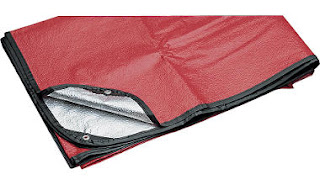 omforters, to further hold in heat and reflect it back at you. Unmodified, this sheet does not breath, and wouldn't let the moisture of your body's sweat escape. You could experiment by punching multiple small holes in it with a grommet hole cutter, allowing some air circulation to wick away dampness, and it would still work effectively.
omforters, to further hold in heat and reflect it back at you. Unmodified, this sheet does not breath, and wouldn't let the moisture of your body's sweat escape. You could experiment by punching multiple small holes in it with a grommet hole cutter, allowing some air circulation to wick away dampness, and it would still work effectively.Left: Reflective tarp from Cabela's
Below: Sooner or later, winter begins to thaw. Yeah!!!
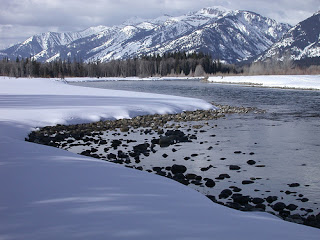
Tuesday, February 12, 2008
Sentimentality Tour '07 - Rocky Mountain Way
Above: 'Aero', back in Banff, AB
ED.Note - You can click on most of the pictures for a larger view.
After driving from the west coast to the east coast and back again, almost 10,000 miles over six weeks, I was getting closer to home. To see the Rockies looming larger on the horizon, reminded me why I had decided to move out West, 24 years ago. The raw majestic beauty of the mountain peaks drew me like a moth to the flame. Tonight I would be back in Banff, AB, and ready to reintroduce myself to old haunts.
I had originally planned to spend a few days in Banff, one resort town which had been an old stomping grounds. But, some people had moved on, and the place had really changed. Banff has started mimicking that upscale (read expensive) resort facade, I like to call 'Whistlerfied', instead of the rustic skibum scene. Saloon type bars like the Cascades (the Zoo), the original King Eddy and Silver City were gone or dandied up. I had a great time hanging with some ol' buds, but decided to leave town sooner than planned.
Left: View of Lake Louise, in front of the Chateau
The next day I cruised to Lake Louise, then up the Banff-Jasper Parkway past the Columbia Ice Fields to Jasper. The glacier behind Lake Louise is almost non-existent this time of year. I used to spend months back country skiing there. The photo displays the area; it's one mile to the end of the lake, but then it's around seven miles past there to the base of the mountains directly behind it. It's a really cool valley, surrounded by high peaks and full of twisted terrain. During the winters' high snowfall, there are avalanches that fall off the back peaks, sometimes 3-4 times daily. From the hotel, they look like dry ice mist or fog being poured over the top ridge, and it sounds like thunder. From on the glacier, it blows your mind, the raw power of nature.
Left: Columbia Icefields
Driving up the B-J Parkway was awe inspiring. I had to concentrate on the road, 'cuz the scenery is spectacular. You start looking around like a kid in a candy store. If you like sightseeing, cruise this highway one day. You won't be disappointed. Halfway up to Jasper, lies the Columbia Icefields, a majestic glacier that once seemed that it would cross over the highway. You can't tell from this photo, but it retreated back at least several hundreds of yards from previous positions, that even I remember. Folks, global warming is a reality and the glaciers are shrinking. I don't any proof, I've seen it.
I was looking forward to the next town, Jasper, with real anticipation. I had enjoyed living there, for almost 3 years, and it was like a homecoming. For me, Jasper and my hometown remained 'true to form' after all this time. They were the two friendliest places on the whole trip. Everyone I dealt with or visited, was glad to see me, and made feel right at home.
Although the Atha-B bar was no longer kickin', the Whistle Stop still rocked like the old days. I spent the first night in town partying with 'new to me' locals, went to a house party/jam and spent the night. The next day I caught up with ol' friends, and it was just great. This is a town, where you can do no wrong. Yeah!
Left: Lac Beauviere, view by Jasper Park Lodge
I'd been on the open road for a long while, and was overdue for some downtime. I wanted to zigzag my way back to the coast, slowly and with deliberation. I needed to hit some back country valleys for 'stationary' solitude. I needed to let myself catch up with all the memories and visions which cascaded through my mind.
 Left: Ingersoll Mountain, Burton, BC
Left: Ingersoll Mountain, Burton, BCThe Arrow Lakes region of the West Kootenays is a great place to go, if you want to get away. From everything. There are a few towns, but that's not much for a couple of lakes that seem to stretch for a hundred miles between wild mountain ranges. The weather was great; dry, warm late summer. Luv it! All I can say, is the photos don't due justice to the area. Check it out if you can, one day.

Right: Facquier, Lower Arrow Lakes, BC
I spent some days just camping by the lake, lettin' time slip by. Eating, drinking, playin' guitar and singing to no one, 'cept the breeze. I thought about how great it would be to have a cabin here. Or maybe somewhere in the interior of BC. I don't know, that's too hard to think about right now. Have a dip, soak up some sun and sip another beer. I ain't goin nowhere. Time has stopped. Rocky. Mountain.. High...
Someone once said, "All good things must come to an end" or something like that. It was time to get down the road. I was going to zip across the Okanagan Valley, up to the Chilcotin region then cut down to Whistler. The Okanagan Valley is BC's wine and fruit region, it's nice but I wasn't stopping this time. I wanted to get up to Clinton and Lone Butte way, before I headed down the Sea to Sky Highway, #99.

Left: Grassland Canyon, South Chilcotin region, BC
The lower Chilcotin region is way different than where I had just come from. Instead of lush thick forest, it has variations of dry arid land, and then there are lakes, rivers, forests, it just changes all around. Very cool.
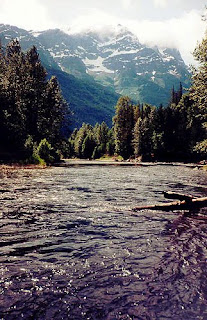
Right: A different view of the Chilcotin region, thick forests with a mountain river
Friends of mine have a ranch up this way. I stopped in over night; we did a little horse back ridin'. I was sore for days 'cuz I ride once a decade or so. This is an area I have thought about home steadin' some. It's not too far north, and it is still relatively quiet. We'll see, ya' never know. Ian and I sat around the campfire that night, playin' a little geetar. He almost had me talked into becoming his neighbor. Not yet, I still have trails to ride.
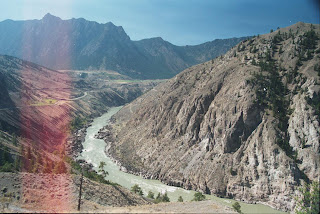
Left: Treacherous valley before Lillolet, BC
It was the last highway towards the coast. The sign read, #99, the Sea to Sky Highway. I turned right, to head toward Lillolet; at that moment I figured I just had driven around 11,000 miles on my trip so far. But this stretch of road is too cool. Chewed up twisted canyons and thick uninhabited bush is the best way I can describe it. Between Lillolet and Mount Currie, it is buried by snow for the winter. Any wildlife you can imagine, grizzlies, cougars, eagles - they all call this area home.
The canyon just before, driving by and past Lillolet is the one craziest roads I've ever ventured on. I was stoked!! Just before, in the canyon pictured above, the road snakes along the left side of the canyon. There's only a couple feet of shoulder, then the ground slopes down at a 30 degree angle and over a cliff down to the raging river below. No railing, no curb. If you drove off the road, I swear they would never find the wreckage. Later, you go through this series of switchbacks, bridges and carved out roads clinging to the side of cliffs, over the river chasm below and up the other side. I can't describe it. I wish I'd put a video camera on the dash looking forward. Wow.
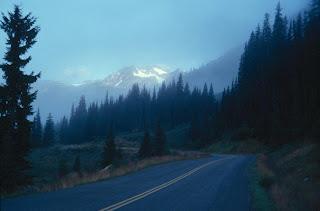
Above: Serenity on the Duffey Lake Road
After that is the Duffey Lake road over to Mount Currie. There is nothing but wilderness, thick bush, raging rivers, nobody for sixty miles or so. It was like a cocoon of forests, left alone by man, except for the road which snaked back and forth over a river on single lane wooden bridges. Everything got very still through this stretch, except for the forward movement of my van heading toward the approaching dusk.
Above: Old home cabin in Whistler, BC
Below: View from my old porch of Whistler Mtn. The ski run to the left will probably be the Men's Downhill course for the 2010 Olympics
Eventually, you come down to the Pemberton valley, and I cruised through to Whistler. My old neighbour, Dave was waiting for me with steaks to grill, and plenty o' beer to drink. For almost 5 years, Dave and I lived in separate sides of the cabin pictured above. Our backyard was Sprout Mountain and frontal view was Whistler mountain across the valley, with Creekside down below.
Those five years were a whole chapter of my life path, and too long to cover here. But for the next four days, I hung out here, in the village and around Whistler valley. Lots of friends, lots of drinks, lots of good times. The folks here are high energy and fun, fun, fun. Only inevitable responsibilities took me away from here, but, I may head back some day.
The last ride. A short drive down to the coast. It was late October '07, the nights were getting longer and cooler; I could feel the change of the season. With the night falling, I drove to Vancouver. Thomas called me to meet him at the Jimmy Dean Tavern. As I stepped out of the van into the light evening rain, it hit me. Time to stop. Home, after 11,300 miles, home again in Van-Coo-Coo. I walked through the door and bellied up to the bar. A modern nomad. Back home from the road.
Sunday, February 10, 2008
Why am I a Vandweller?
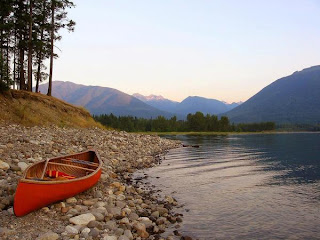

Wednesday, February 6, 2008
Buying a Vehicle - More on Form Follows Function

Left: Chevy Astro minivan
1/ Minivans - This is the type of vehicle that I use. You can usually expect decent fuel mileage in the area of 17-18 mpg in the city, and around 22 mpg on the highway. Good fuel economy is important if you are plan to drive a lot on a tight budget. Space is also tight; you'll need to be very organized. I like two particular models, the older Chevy/GMC Astro/Safari and the Ford Aerostar. These vehicles were built light truck tough; they have proper chassis with rear wheel drive; they can handle some payload and are proven performers. You can buy a used one for a reasonable price, and they are boxy in shape, which make them easier to build out. I also call them midivans; they are larger inside than most of the new front wheel drive minivans. They are easy to park and maneuver through city streets, or twisty dirt roads. One warning though, the Aerostar is very tight for space under the hood when servicing; patience is required.
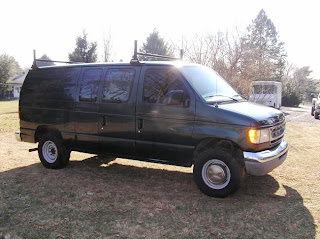
Left: Ford E250 cargo van
2/ Full-Size Van - The average vandwellers choice. Fuel economy is usually around 14 mpg in the city, and 18-19 mpg on the highway. With more space comes less fuel efficiency. It depends on your preference and budget. For many people who don't travel as much, or use their vehicle for long distance daily driving, the extra space is most welcome and affordable. Ford, GMC/Chevy, Dodge are all good dependable vehicles, but, I still seem to prefer Fords or GMC's. These vehicles are built truck tough; they have proper chassis and rear wheel drive which can handle good payloads and abuse. They are boxy, so they can be easily built out for living in, and are proven performers. The 3/4 ton size van is a good mix of heavy duty running gear, suspension balance and handling for a built-out van. They are still not too large for city use or tight spaces when parking, and can be used for stealth parking if prepared properly. My dream van would be a Ford E250, with factory dual fuel (gas and propane) if possible, with a I-6 300 cu.in or small block V-8 engine.
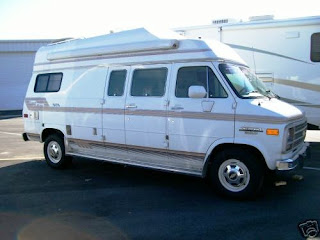
Left: Fully equipped Camper Van
3/ Camper or Conversion Van - These vans are pre-built out vans by outfitting companies, for either camping or limo service, built on the full-size van platform. They can be a solution for some people, but you are buying someone else's idea about layout, creature features, etc. Because they are already kitted out, they come with a higher price tag; the extra weight will effect the fuel efficiency to varying degrees; usually around 10 mpg in the city and 15 mpg on the highway. It's pretty obvious someone is living in a camper van, though you still have good stealth with a conversion van. They are made with the regular or extended version of the full-size van, so they operate similarly.
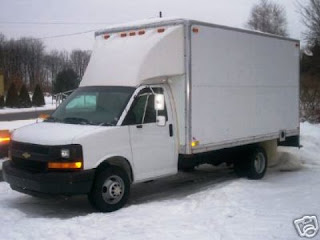
Left: GMC Box Van
4/ Box Van - These are usually the one ton version of a full size van, modified with a large cube or 12'-14' box over the rear chassis. They are usually classified as commercial vehicles, so, there are challenges involved with parking, insurance, and operation regulations/expense. They do have lots of room in the cube, but again you lose fuel economy ( 7 mpg in the city, maybe 10 mpg on the highway). They are difficult to park on city streets, pretty tricky/heavy to drive on dirt roads, and expensive to service/buy parts for. Some people prefer this type of vehicle, but I believe that unless you really want one, the average person would be better off with just a standard van for ease of retrofit, service and economy.

Left: RV Motorhome
5/ RV or different class Motorhomes - These are the preferred palatial vehicles of the older generation. They will usually have a built-in washroom, kitchen area, big bed, and so on. Think bigger price tag, more custom parts with specialized servicing, lower fuel economy, no stealth factor, difficult to maneuver and park. But, you have very comfortable digs. If I was living only in the country, and could find cheap camping/RV parks, they would be nice. But forget about easy operation in the city, and long distance traveling/daily driving would be expensive (8-10 mpg combined driving).
For myself, I like vehicles that are commonplace and mechanically stock, like my mini-van or a full-size van. Parts are available everywhere; from dealerships, parts stores, wreckers whethor new or used. Because they are stock vehicles with only cosmetic mods, they are readily serviceable by many garages, and are easier to work on for the home mechanic. When you get into specialized or commercial vehicles (types 3-5), your options for parts and service become more limited and expensive.
I believe fuel economy is a paramount consideration for the nomadic vandweller. Last year, I went on a 11,700 mile road trip with my Aerostar, which cost approx. $2400 for fuel in Canada (pretty good). With a lightly equipped full size van, the same trip would've cost $3100 (not bad); a fully modified camper van, $3900 (oh, oh!); a RV, $5,800 (ouch!). I live a streamlined lifestyle, so I prefer having the economy of a smaller, less equipped vehicle, instead of a palatial RV. I like being able to allocate my money to other choices, instead of just fuel!
ed.note - MPG ratings listed here are an approximate average for US gallons, larger Canadian gallons result in a 20% higher rating. But, Canadian gas costs more per same size unit!
Monday, February 4, 2008
Buying a Vehicle
1/ Decide on what you want: There are quite a few criteria you'll probably face when purchasing your new home. That's right, home. Changes your perspective a little bit, eh. Year range, model type, amount of money to spend, fuel economy, vehicle quirks; these are all important factors. But, take some time to look around and research your desired vehicle. You want to get it right, as much as possible the first time.
2/ Form Follows Function: When I bought my van , I was only getting something to camp weekends in, so I bought what I call a midivan, an extended Ford Aerostar. But, if I had been buying a van to be my home, I probably would have bought a full-size Ford E-series or equivalent. That would provide more living room inside, with only a 20% sacrifice in fuel economy. If I lived in a colder climate (snow on the ground for 3-4 months), I would definitely go for the full size. Depending on where you live, you might want a camper van or RV, but those are not really suitable for urban stealth sleeping or efficient fuel economy. Think about your choice!
Below: My '89 Ford Aerostar. Paid $1500, still has only 103K miles on the clock after two years driving, no rust, no leaks. The bare minimum for a full-time vandweller, but good gas mileage and reliable!
3/ Money range (Fuel Economy): Without a doubt, this will be the deciding factor of what you can buy. For myself, I have always taken a long time (weeks, if not months) to find my vehicles; I shop for the best deal, buying the vehicle for as cheap as possible. If you are in a hurry, you might make a rash decision you will regret later.
I like buying vehicles that usually are ten years old or more, but haven't been worked too hard, with not more than a 100K miles on the odometer. Also, fuel economy is a consideration, so I avoid large blocks engines. I also like that vehicles that are very commonplace; there will be lots of parts available, and service will be provided almost everywhere.
4/ Mechanical Condition: When buying a used vehicle, ascertaining the mechanical condition is paramount. If you buy something cheap with tons of miles (200K +) on the clock, then you will spend thousands to fix it up, and you'll still have a worn out vehicle that will break down anytime. If you keep it long, you'll end up rebuilding the vehicle. That's why I suggest you get a vehicle with around 100k miles or less; it should have lots of life left in the engine and drive train, and should be reliable requiring only regular maintenance for a few years.
Insist on taking the van for a good test drive before purchasing, and try to get some highway driving in it. I usually get the owner to drive the vehicle at first, so I can listen for noises (turn the radio off!!!) that indicate repairs needed. I also observe their operation while driving; are they doing something to compensate for repairs necessary. Then I take over to see how the vehicle feels; is the front end loose, the brakes working properly, the vehicle accelerating fine? Do all the lights work, the stereo, the air conditioning, etc.?
Check it over ruthlessly, for you're the one stuck with the problem after you drive the vehicle away. Take something to lie on, and check under the vehicle, looking for leaks and overall condition. Ask questions about the vehicle and for any receipts, so you varify alleged repairs and odometer mileage. Owners usually value their vehicle on it being in proper mechanical shape, so if it isn't, that lowers the resale value. Why? Because you'll be stuck with the repair bill later, adding more to the overall expense of the purchase.
5/ It All Depends: Whatever vehicle you buy, hopefully you can use it for a long time. If so, it's gotta' feel right to you, and there are so many variables to be considered. Take your time!! You're the one with cash in hand, so you are in control. Get what you want and need, not just what someone is trying to sell you. Happy motoring!
Saturday, February 2, 2008
Sentimentality Tour '07 - The westward road.

Above: Ontario fall colours beginning to show
When it was time to leave Toronto, I was looking forward to the ride back to my adopted homeland, Coastal BC. But, that area is located some 3,000 miles west of Toronto, so, I had some driving to do. I wanted to spend some extra time in places I'd lived before (Banff, Jasper, Whistler), which meant I travelled quickly through Northern Ontario and the Prairies.

Left: Cottage country, 2-3 hours north of Toronto
Travelling north of Toronto and eventually heading west, you travel up and over the Precambrian Shield. This huge land mass lies across the northern area of Ontario, Quebec and parts of Manitoba. There are thousands of lakes, surrounded by rugged rocky shores, dense forest and wilderness. I spent many summers enjoying the cottage counties of Haliburton and Muskoka, while growing up in Toronto. The Shield seems to go on forever; once I got to Muskoka county, I didn't get out of this type of geography until Manitoba, over a 1,000 miles later.

Left: North shore of Lake Superior
One lonely stretch of wilderness along the Trans-Canada Hwy, is between Sault Ste. Marie and Thunder Bay, skirting the north shore of Lake Superior. The highway went up and down over tall hills and deep valleys, cut by glaciers through the deep rockbed of the Shield. The shoreline displayed craggy rockfaces carved by the erosion of time. Once in a while, there would be an exposed sandy beach, in one of the many bays off the highway.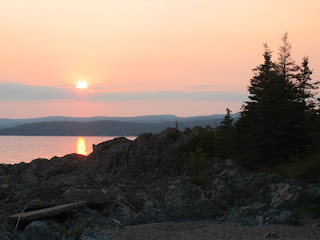
Left: Sunset close to Terrace Bay, north shore of Lake Superior
This is one stretch of highway, I suggest you stay away from the semi trucks. They speed down into the valleys, to pick up momentum for the slow hill climb up the other side. I camped along the north shoreline twice; the open expanse of water is so great, you feel like you are on an inland sea. You are, they just call it a lake. The winter storms are legendary here, and the wilderness never ending.
Left: Terry Fox Memorial
At Thunder Bay, the Trans-Canada cuts northwest up over the Shield, away from Lake Superior past Dryden and Kenora, and eventually down to the Prairies. I stopped for lunch at the Terry Fox Memorial. In the early 80's, Terry was a victim of cancer, who decided to make a great sacrifice. Despite great pain and a artificial leg, he attempted to run across Canada from coast-to-coast, to raise money and awareness for cancer research and treatment. He motivated our whole country, and the image of Terry running was on the nightly news. Unfortunately, he only made it to Thunder Bay from the East Coast; still a great achievement considering his affliction. On his memorial, a quote of his says, "Dreams are made, if people only try. I believe in miracles, I have too... because somewhere the hurting must stop."
The trip up to Dryden and over to Kenora reveals more lakes, rocky crags and thick forests. It seems like it will gone on forever, 'cus it does. Eventually though, you get through. You pass a time zone marker, and the sign says you are entering Manitoba. I stopped, got out and looked back at Ontario, my native province. My life had started there, but, I still felt it was not meant to end there. I drove on into the night west toward Winnipeg, Manitoba.
Left: Prairie country road
The next day, I drove north off the Trans-Canada, to the lake country of Manitoba and Saskatewan. I'd had never been to this area, and I had always wanted a quick look. The prairies are pretty flat, farming countryside, so these huge lakes have always picqued my curiousity. The region has some rolling hills, and except for some river valleys, it is mostly pretty flat. You can see for miles and miles, over the open expanse. In the lake country however, there are some huge lakes. In the glacier age, Manitoba was apparently almost completely under water. These lakes are what remain.
Left: Lake Manitoba shoreline
Driving northwest from Winnipeg to the Narrows, at one point I was heading parallel of the lakeshore of Lake Manitoba, a quarter-mile to the east. But, I couldn't see it! A quarter-mile from a 50 mile wide lake, and I couldn't see it! I took the next dirt road west, drove 250 yards west, and there it was. The land is so flat, that if the water level rose 10-15 feet,it wouldn't be 50 miles wide anymore; it would 80-90 miles wide.
Left: Grain Elevator, near Ste. Rose, MB
Although you would think the Prairies would be boring, actually, that's not true. A couple of valleys caught me by surprise. One was Lake of the Prairies, and the other was the Q'uappelle Valley. You would be driving along through flat farming lands, then, down into a valley by a big lake in cottage country, with different trees, water-skiing, camping, etc. If you kept going, 5 minutes later, you drive up the other side, and you are back into flat farming land again. Weird!
Left: Church in Lebret, SK
There were lots of places of interest, different areas and wildlife, I didn't realize existed on the Prairies. There was way more deer that I knew lived there; with numerous warning signs on the road. In the Q'uappelle valley, I was driving through a kinda modest town, around 100 or so rather run down houses. I look over to my left down by the lakeside, and here is a magnigicant stone church! Completely out of character with the rest of the town. It's obvious that religion is alive and well in these parts.In the morning after camping by Lake Q'uappelle, I hiked up to high ground. There was major storm clouds to the northwest, and some clearing of the storms to the southwest. I decided to cut back down to the Trans-Canada, and cruise quickly towards Banff. It was a rainy day; you couldn't see much in the way of scenary. As it cleared later, I could see the mountains looming on the horizen. I was getting closer to my adopted homeland, the Rocky mountains of Alberta and BC. I smiled as I drove toward the sunset. Homeward bound!
Below: Rocky Mountain High!
